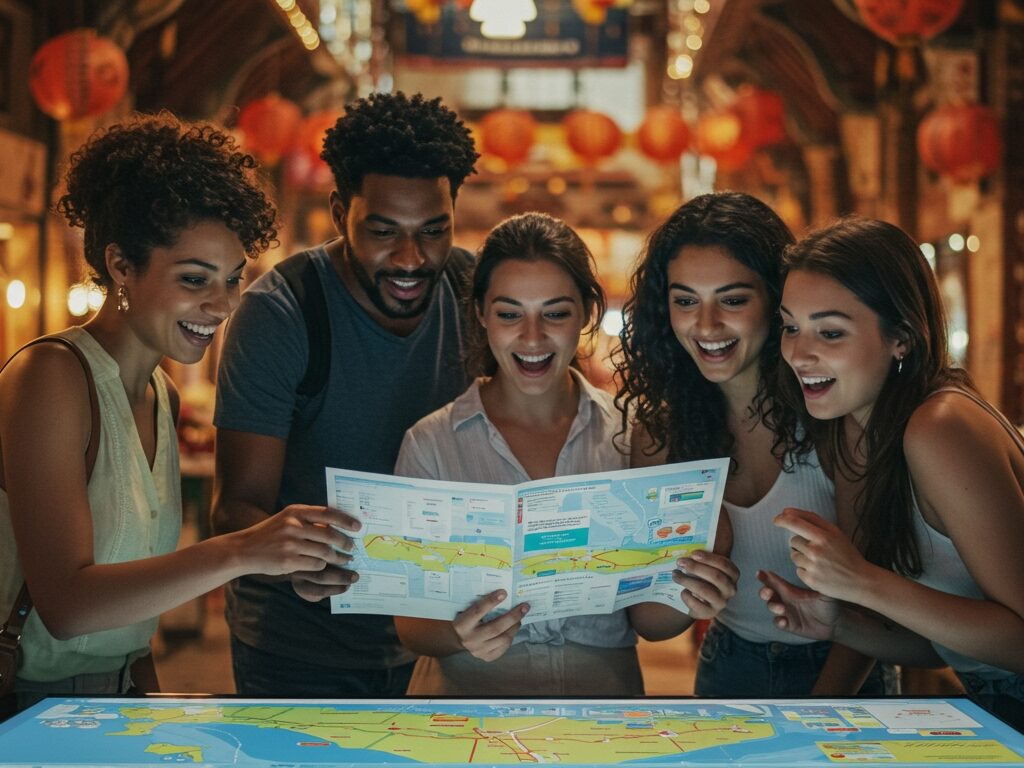Unrivaled Journeys: Using AI for Hyper-Realistic Travel Itineraries – Your Ultimate Guide
Gone are the days of generic, one-size-fits-all vacation plans. In an era where every experience can be tailored, the realm of travel planning is undergoing a revolutionary transformation. Enter artificial intelligence (AI), a powerful ally making it easier than ever to craft truly unique and unforgettable adventures. This guide explores the incredible potential of using AI for hyper-realistic travel itineraries, taking your bespoke journeys from dream to meticulously detailed reality.
Key Takeaways:
- AI revolutionizes travel planning by offering unparalleled personalization, efficiency, and cost optimization.
- Hyper-realistic itineraries go beyond basic suggestions, incorporating logistical nuances, personal preferences, and real-time data.
- Effective AI use involves clear prompting, refining outputs, and a crucial human touch for verification and emotional resonance.
- While powerful, AI has limitations, including potential for outdated information and a lack of nuanced local insights, necessitating human oversight.
- The future of travel planning is a synergistic blend of advanced AI tools and human expertise, creating richer, more authentic adventures.
Why AI is a Game-Changer for Modern Travel Planning
Imagine a travel planner that not only remembers your past trips and preferences but also understands your mood, budget, and even your desire for spontaneous detours. That’s the promise of AI in travel. It’s more than just automation; it’s about intelligent anticipation and unparalleled customization.
AI algorithms sift through vast datasets of travel information, from flight prices and hotel availability to local events and restaurant reviews, in mere seconds. This capability allows for the creation of itineraries that are not just comprehensive but deeply personalized. Users on platforms like Reddit often express frustration with the overwhelming nature of traditional planning and the desire for authentic, off-the-beaten-path experiences – precisely where AI shines. It can recommend hidden gems or unique activities that might otherwise be overlooked, truly enhancing the travel experience.
Beyond personalization, AI brings efficiency. It streamlines the typically time-consuming tasks of research and comparison, allowing travelers to spend less time planning and more time looking forward to their trip. Real-time updates on deals, weather, or even unexpected closures mean your itinerary can dynamically adjust, saving you from potential headaches on the go.
The Core Concept: What Makes an Itinerary “Hyper-Realistic”?
A “hyper-realistic” travel itinerary isn’t just a list of attractions; it’s a meticulously constructed plan that mirrors the actual flow and feel of a journey. It factors in elements that often trip up traditional planning, creating a seamless and practical experience. This includes:
- Logistical Precision: Accounting for realistic travel times between locations, considering local transportation, walking distances, and even potential wait times at popular attractions. This prevents over-scheduling and ensures a relaxed pace.
- Personal Pace & Preferences: Tailoring the schedule to your energy levels (e.g., late starts for night owls, early mornings for adventurers), preferred meal times, and specific interests like food tours, historical sites, or quiet beach days.
- Budget Alignment: Generating options that genuinely fit your financial constraints, from budget-friendly accommodations to luxury experiences. AI can actively search for deals and cost-effective alternatives.
- Local Context & Nuance: Incorporating details about local customs, peak tourist seasons, weather patterns, and even suggesting routes that offer picturesque views or avoid heavy traffic. This moves beyond generic guidebook entries.
- Contingency Planning: While not always explicit, a hyper-realistic plan implicitly builds in flexibility or suggests alternative activities in case of unforeseen circumstances like bad weather or unexpected closures.

Step-by-Step Guide: Using AI for Your Bespoke Journey
Crafting your perfect AI-powered itinerary involves a blend of smart prompting and human refinement. Here’s how to do it:
1. Define Your Vision: The Inputs for AI
Before you engage any AI tool, clarify your travel desires. The more specific you are, the better the AI’s output will be. Consider:
- Destination & Dates: Specific cities, regions, or even a broad country with desired travel window.
- Travel Companions: Solo, couple, family with kids (specify ages), group of friends.
- Interests: History, art, food, adventure, relaxation, nightlife, nature, shopping, specific hobbies.
- Pace: Fast-paced, leisurely, balanced.
- Budget: Economy, mid-range, luxury (provide a numerical range if possible, e.g., “$X per day excluding flights”).
- Must-sees & Must-dos: Any non-negotiable attractions or activities.
- Preferences: Dietary restrictions, accommodation types (boutique hotel, Airbnb), preferred transport, desired atmosphere.
2. Choosing Your AI Travel Assistant
Many tools are emerging, each with strengths. Popular options include dedicated AI travel planners like Mindtrip, Layla (formerly Roam Around), Wonderplan, and Trip Planner AI. General-purpose AIs like Google Gemini or ChatGPT can also be prompted for itineraries, often integrating with travel search engines like Kayak or Tripadvisor for booking links.
Some, like Tripadvisor’s AI Trip Planner, leverage extensive user reviews, while others, like Mindtrip, offer dynamic interfaces with map integration and real-time updates. Experiment to find one that resonates with your planning style.
3. Crafting Your Prompt: The Art of Asking
This is where your detailed vision from Step 1 comes into play. Think of your prompt as instructing a highly intelligent, albeit literal, travel agent. Be comprehensive and clear.
Example Prompt:
“Plan a 7-day hyper-realistic travel itinerary for two adults visiting Rome, Italy, from October 10-17. Our budget is mid-range ($200-300 USD per day for activities and food, excluding accommodation). We love ancient history, authentic Italian cuisine, and discovering charming local neighborhoods. We prefer a balanced pace with some relaxation time, avoiding overly crowded tourist traps where possible. Include realistic travel times between attractions via public transport/walking, and suggest specific, highly-rated local eateries for lunch and dinner. Propose accommodation in the Trastevere area. Ensure the plan accounts for jet lag on day one.”
Follow-up prompts are crucial: “Can you suggest a cooking class focused on Roman pasta?” or “Adjust Day 3 to include a leisurely afternoon in Villa Borghese instead of the Pantheon, and recommend a nearby gelato shop.”
4. Refining AI Outputs: The Essential Human Touch
AI is a fantastic starting point, but it’s not infallible. It might “hallucinate” (make up information), provide outdated details, or miss subtle nuances. Always cross-reference critical information:
- Verify Opening Hours & Prices: Check official websites for attractions, museums, and restaurants.
- Confirm Transportation: Look up public transport schedules and routes.
- Read Recent Reviews: Use sites like TripAdvisor or Google Maps to gauge current popularity and quality of recommended spots.
- Consult Local Forums (Reddit/Quora): Search for recent discussions on specific areas or activities to get genuine, up-to-date local perspectives. Are there any local festivals during your visit? Are there hidden gems only locals know about?
5. Integrating Logistics & Bookings
Once you’re satisfied with the itinerary’s framework, use the links provided by some AI tools, or manually proceed to book flights, accommodations, and any pre-bookable tours or popular restaurant reservations. Many AI tools will either offer direct booking links or guide you to platforms where you can complete these steps. Keep all confirmation numbers and important documents organized, perhaps in a digital folder or a dedicated travel app.
For seamless management, consider using a dedicated travel organizing app like TripIt to consolidate all your bookings into a master itinerary. This can be especially helpful for sharing details with travel companions.
6. Real-Time Adjustments & Flexibility
Even the most hyper-realistic itinerary needs room for spontaneity. AI tools are increasingly offering dynamic adjustments based on real-time data, like weather changes or transit delays, and can suggest alternative activities on the fly. However, it’s always wise to build in some buffer time or optional activities to avoid feeling rushed. Embrace unexpected discoveries – sometimes the best travel memories are unplanned!
Advanced Tips for Next-Level AI Itineraries
- Leveraging Local Insights from Communities: Use Reddit communities (e.g., r/travel, city-specific subreddits like r/london, r/asknyc) and Quora for “insider” tips. Ask AI to analyze these discussions for common recommendations or warnings, then integrate them into your prompt for even richer results. For instance, asking, “What are some under-the-radar coffee shops in Shoreditch, London, that locals frequent?” will yield more authentic results than just “coffee shops in London.”
- Budget Optimization Beyond Basics: Don’t just give a range; specify areas where you’re willing to splurge versus save. For example, “Prioritize spending on unique dining experiences but find budget-friendly, well-located accommodation.” AI can then scour for deals, predicting fare fluctuations and notifying you of optimal booking times.
- Off-the-Beaten-Path Discoveries: Explicitly tell the AI you want to avoid mainstream tourist paths for certain days or activities. Use prompts like, “Suggest a day exploring lesser-known historical sites near Edinburgh, avoiding the Royal Mile,” or “Find a unique cultural experience in Sydney that isn’t the Opera House or Harbour Bridge.”
- Contingency Planning with AI: Ask your AI, “What are some good indoor activities in [City] for a rainy day?” or “What are alternative routes if [major train line] is disrupted?” Having these pre-planned alternatives can save significant stress during your trip.

Common Challenges and How to Overcome Them
While AI offers incredible advantages, it’s not without its pitfalls:
- “Hallucinations” and Factual Accuracy: AI models can sometimes generate plausible-sounding but entirely false information. This is why human verification (Step 4) is non-negotiable. Always double-check critical details like addresses, opening hours, and booking information directly with reliable sources.
- Outdated Information: AI’s training data might not be current, especially for rapidly changing details like temporary closures, new attractions, or evolving local regulations. Combine AI’s speed with real-time searches and current reviews.
- Lack of Emotional Intelligence and Human Touch: AI cannot understand the subtle emotional nuances of a special anniversary trip or the unique dynamics of a family with specific needs. This is where a human travel advisor or your personal judgment remains invaluable. AI is a tool, not a replacement for human intuition and empathy.A balanced perspective from Travel + Leisure highlights this.
- Over-Reliance on AI: Blindly following an AI itinerary without critical thought can lead to a less fulfilling trip or missed opportunities for serendipitous discovery. Use AI to inform, not dictate, your journey.
- Data Privacy Concerns: Many AI tools collect personal data to offer tailored recommendations. Be mindful of the privacy policies of the tools you use. Consider how much personal information you’re comfortable sharing.
The Future is Bespoke: A Human-AI Collaboration
The rise of AI in travel doesn’t signal the end of human travel planning; rather, it ushers in an era of unprecedented collaboration. AI excels at processing data, identifying patterns, and generating possibilities. Humans bring intuition, emotional understanding, the ability to discern truly unique local experiences, and the critical thinking to verify and adapt information. By skillfully using AI for hyper-realistic travel itineraries, you transform planning from a chore into an exciting co-creation process.
Embrace these powerful tools to unlock a new dimension of travel – one where every journey is meticulously crafted, deeply personal, and truly unforgettable. Your next bespoke adventure awaits.
Here are some additional resources for your planning journey:
Frequently Asked Questions About AI Travel Planning
Q1: What is the best AI for travel planning?
A1: There isn’t a single “best” AI, as different tools excel in different areas. Dedicated platforms like Mindtrip, Layla, Wonderplan, and Trip Planner AI are highly regarded for generating detailed itineraries. General AIs like Google Gemini and ChatGPT can also be effective, especially when paired with plugins or specific prompts. The best tool for you will depend on your specific needs, preferred interface, and the level of detail you require.
Q2: How can I create a truly realistic travel itinerary with AI?
A2: To create a hyper-realistic itinerary, provide the AI with highly specific inputs, including your travel pace, budget, interests, preferred transportation, and even desired “mood” for the trip. Always ask the AI to factor in realistic travel times between points and suggest local, rather than just touristy, experiences. Critically review the output, verifying details like opening hours, transportation routes, and restaurant availability with current, authoritative sources. Integrating human insights from forums like Reddit can also add realism.
Q3: Can AI replace human travel agents entirely?
A3: Not entirely. While AI offers immense benefits in efficiency and personalization, it cannot fully replicate the nuanced understanding, emotional intelligence, and real-time problem-solving skills of an experienced human travel agent. AI is a powerful tool to assist and enhance planning, but a human touch remains invaluable for complex trips, unexpected issues, or for those seeking truly unique, insider knowledge that goes beyond data aggregation.
Q4: What are the main benefits of using AI for travel planning?
A4: The primary benefits include unparalleled personalization, tailoring itineraries to your exact preferences; significant time savings by automating research; cost optimization through real-time deal detection; discovery of hidden gems and unique experiences; and the ability to dynamically adjust plans on the go based on live data like weather or traffic.
Q5: What are the main disadvantages or limitations of AI in travel planning?
A5: Key disadvantages include the potential for AI “hallucinations” (generating false information), reliance on potentially outdated data, a lack of human emotional intelligence or nuanced local insight, privacy concerns related to data collection, and the risk of over-reliance leading to a less spontaneous trip. Human verification and critical thinking are essential to mitigate these limitations.”
















Add a Comment